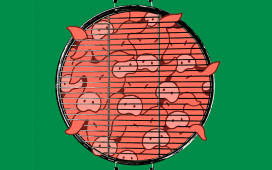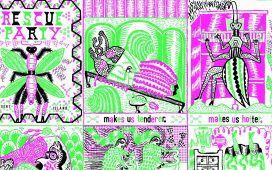In July, 2019, the documentary filmmakers Jessica Wolfson and Jessie Auritt met Millicent McCrory, a local housepainter, for lunch on the south side of Austin, Texas; they had heard about Millicent, or Millie, from a close friend, and they hoped Millie would agree to appear in a short film. When we spoke earlier this month, Wolfson recalled that Millie arrived at their lunch “dressed to the nines,” wearing a crop top, a plaid miniskirt, and a pair of colorful cat ears planted jauntily atop her head. Their lunch lasted nearly four hours. “She laid her life story out on the table,” Auritt said. “She was like, ‘You want to hear about my childhood? Here it is.’ She was an open book.” Millie was candid and honest, and she quickly agreed to appear in their film.
Wolfson and Auritt shot their short documentary, “The Paint Wizzard,” throughout the summer and fall of 2019. (The film takes its name from Millie’s painting company. “I move fast fer a one girl operation!” she explained via text.) Millie is their charismatic star. Born into a Mormon family in Texas as Michael McCrory, Millie chose a new name and left behind her assigned gender a few years ago, at the age of fifty-eight. “Are you a girl?” a woman asks, in an early scene, as Millie shops for new clothing at a local Savers wearing an orange miniskirt, vibrant as a traffic cone, and a black camisole. “Yes. Yes!” Millie replies emphatically, smiling. “I want to make that clear. I can’t help that I’m stuck in a boy’s body, dressing as a girl.” When the woman asks if she’s transgender, Millie sobers, leaning on the handle of her shopping cart before responding, “Well . . . that’s the umbrella it falls under.” Throughout the film, it becomes clear that Millie doesn’t feel entirely comfortable under any one label—she accepts the term “transgender,” but only because she feels the pressure to fit herself into one predetermined package. “I’ve gotten used to it, but I don’t like it,” she says at one point. “I’m just a painter in a dress.”
Millie is searingly honest about the contradictions she feels about her identity. On one hand, she loves the trappings of femininity, like her swingy dresses and multicolored baubles. But in other moments, grief and confusion burble up. “It’s tough to be somebody that you don’t even understand,” she says. In one scene, she shaves her chin and carefully applies mascara to her eyelashes before asserting that she would not wish the “curse” she lives with upon her worst enemy. “Millie still struggles and is very open about that struggle, that inner fight she has with herself,” Auritt noted in our conversation. And yet, the process of expressing herself brings Millie happiness. “It’s a curse I love, too,” she finishes. “Because I’ve certainly indulged it.”
Millie’s vibrant clothing—like a crimson ruffled skirt or a bright marigold camisole—makes her easy to spot while she paints, whether she’s balancing on a rickety ladder or hanging out a window with her paintbrush, delicately dabbing at trims and gables. She’s good at her work and she takes pride in her skill; her houses are meticulously detailed, their façades even and glossy. It’s soothing to watch Millie cover an old white house with fresh blue-gray paint. Her expertise is a source of confidence. “I like knowing what I’m talking about, for one thing in my life,” she says, her arm swinging back and forth steadily as she layers the paint in even lines across the house’s clapboard siding. “It just makes me feel blessed that somebody believes in me. That means something. It means a lot.”








